2025 Weingut Nikolaihof Offer
An array of current & late release wines including:
The epic 1997 Vinothek Riesling in Magnum!
Riesling ~ Grüner Veltliner ~ Muskateller ~ Neubruger ~ Gewürtztraminer Chardonnay
***All wines are Super Dry with the exception of the Off-Dry Gutswein Riesling***
Wines will arrive October 2025
THERE WILL BE ONLY ONE SHIPMENT THIS YEAR
THE IMPORTER WILL ONLY SHIP WINES THAT HAVE BEEN PRE-SOLD
All requests are subject to allocation.
Invoicing will be upon confirmation.
The Current Release Varietals
2024 Neuburger ‘Aus den Garten’
From $101ea
2022 Chardonnay ‘Aus den Garten’
From $101ea
AK 90
2023 Gelber Muskateller ‘Aus den Garten’
From $101ea
The Current Release Rieslings
2017 Riesling ‘Gutswein’
From $101ea MAG’s $237ea
AK 93
2019 Riesling Smaragd Ried ‘Vom Stein’
From $177ea MAG’s $397ea
AK 94 SR 93
2017 Riesling Ried ‘Steiner Hund’
From $217ea MAG’s $476ea
AK 95 SR 94+
2015 Riesling ‘Baumpresse’
From $307ea
AK 95
2008 Riesling ‘Vinothek’ (bottled 04/24)
From $452ea MAG’s $946ea
AK 95 SR 96
1997 Riesling ‘Vinothek Fass Severin’
MAGNUM ONLY $1,191ea
AK 97 SR 97
The Museum Release Rieslings
Riesling Federspiel Ried ‘Vom Stein’
2005 from $221ea MAG’s $486ea
SR 94
Riesling Smaragd Ried ‘Vom Stein’
2008 from $278ea MAG’s $598ea
SR 93
2012 from $258ea MAG’s $557ea JEROBOAMs 3L $1,244ea
DS 92 SR 93
2016 (bottled April 2021) from $238ea MAG’s from $517ea
SR 94
2017 from $217 MAG’s from $478ea
JEROBOAMs 3L $1,084ea 6L $2,037ea
SR 94
Riesling ‘Klause’
2007 Klausberg Riesling Privatreserve
From $406ea
2014 Klause
From $345ea
SR 94
Riesling Ried ‘Steiner Hund’
2014 from $277ea MAG’s from $596ea JEROBOAMs 3L from $1,322
SR 94
2016 from $277ea
SR 95
Riesling ‘Steinriesler’
2007 from $316ea MAG’s $675ea
SR 98
Riesling ‘Baumpresse’
2012 from $387ea
SR 96
The Current Release Grüners
2019 Grüner Veltliner Smaragd Ried ‘Im Weingebirge’
From $163ea MAG’s $368ea
AK 95 SR 92+
2012 Grüner Veltliner ‘Steinterrassen’ (bottled 05/23)
From $196ea
AK 94
The Museum Releases
Grüner Veltliner ‘Hefeabzug’
2020 from $103ea
SR 91
Grüner Veltliner Federspiel Ried ‘Im Weingebirge’
2007 $212ea
SR 93
2013 from $172 MAG’s $387ea JEROBOAM’s 3L $902ea
DS 93 SR 91
Grüner Veltliner Smaragd Ried ‘Im Weingebirge’
2015 from $223ea MAG’s $489ea
SR 96+
Prologue
The love of wine yields pain and pleasure. The further down the rabbit hole you venture the harder it becomes to find wines that are exhilarating.
The very top end of Nikolaihof’s wines achieve this feat.
I kept hearing about Nikolaihof yet somehow never managed to try any of their wines.
I managed to wangle a few bottles from Tim’s reserve to do some QA and get my eye in before compiling this offer. It took around 30 seconds of looking at these to push the go button.
- 2021 Muskateller
- 2016 Riesling Fiederspiel Late Release
- 2013 Baumpesse Grüner Veltliner Im Weingebirge
Since that initial tasting I’ve had the chance to devour an array of their wines. All have impressed.
Today’s offer includes the 1997 Vinothek Riesling that spent 25 years in 3,500L foudre before release. Its predecessor was the first Austrian wine to be awarded a perfect 💯!
I guess when you can trace your history back to 63BC extended maturation in Foudre for 25 years is just a blip in time.
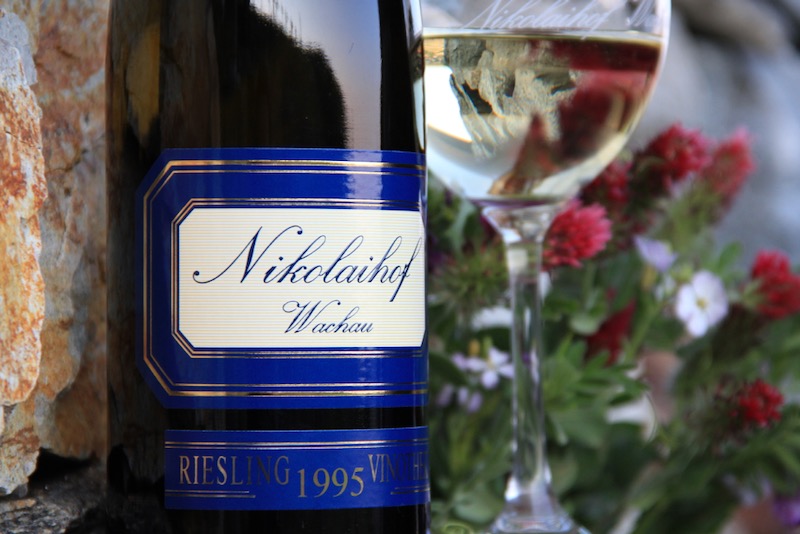
These are remarkable wines!
In the ‘Wine Decoded Tasting Revolution’ available free to members, I explore the key elements of exceptional wine.
There are two criteria specifically that take Nikolaihof’s extended maturation & Vinothek wines to the upper echelons.
First development and freshness
The overwhelming majority of wines are released within 1-3 years and the job of achieving peak maturity is left to the consumer.
Nikolaihof’s wines see significant time in foudre, 5-25 years.
During that time, Nikolaihof give their wines the care a mother would their children. By the time they are released to us we’re devouring a mature and wise child, these nectars retain the energy and vitality to have you walking away refreshed.
Second, overall beauty, style or personality if you wish
It is a rare beast that completely entrances with sheer beauty, balanced with a naughty edge so carefully placed that it doesn’t detract from the intoxicating nature of a wine. To be wise to the world and present itself as humble, gracious, and complete, surpassing the highest of expectations is the holy grail.
Nikolaif’s vineyards proffer ripe fruit, at alcohol levels on the low end of the spectrum. This might sound like a technicality, the impact in the glass is significant. It’s only possible to pick ripe fruit at this alcohol when you have old, balanced vines that have seen attention to detail not just across a year but across decades.
Such intensity is typically seen at much higher alcohol in Austria. Achieving flavour and phenolic ripeness at lower alcohol levels has the benefit of giving a wine greater natural acidity, freshness, energy, and a weightlessness, feather-light feel not otherwise possible. I saw this time and time again making the wine at Yarra Yering. Our vintage would be finished before many were even halfway through picking!
Nikolaihof’s wines start at a high base & step up to the plate at each price point!
You can explore the entire range below with confidence.
About Weingut Nikolaihof
On the eastern edge of the Wachau valley, there lies Nikolaihof, in the quiet village of Mautern.
In its current manifestation, Nikolaihof is a wine estate, yet it has lived many lives. The wines of the house are a singular experience: the combination of unique Wachau terroirs with ancestral technique blends together in this place to form something at once ancient, yet novel in the contemporary wine world. Decisions here are not dictated by the market or trends.
Nikolaus Saahs (Jnr) runs the Nikolaihof estate on strict biodynamic principles and it is possibly Europe’s first ever biodynamic winery with the practices being used since 1971 (before Nicolas Joly even!). They were certified in the early 1990s.
Away from the vini/viticulture side of things, they also practice what they preach, running their estate as a small bio-farm; growing and making all manner of produce to serve alongside local fare in their weinstub, as well as serving produce from other local likeminded producers.
Nikolaihof is a realm dense with historical memory. These memories and a winemaking ethos built upon tradition provide the backbone for many of the hallmarks of Nikolaihof. Wines are released when they are ready not necessarily when the market wants them. Fermentation and elevage are never rushed or hurried. Harvests are unique in the vineyards of Nikolaihof. Due to the strict use of biodynamic preparations and vineyard management, the estate is often able to achieve grape ripeness well before their more conventional-farming neighbors. The rhythms and cycles of Nikolaihof are all their own. They are continuing traditions and living in a history with deeper roots than almost any estate in Europe.
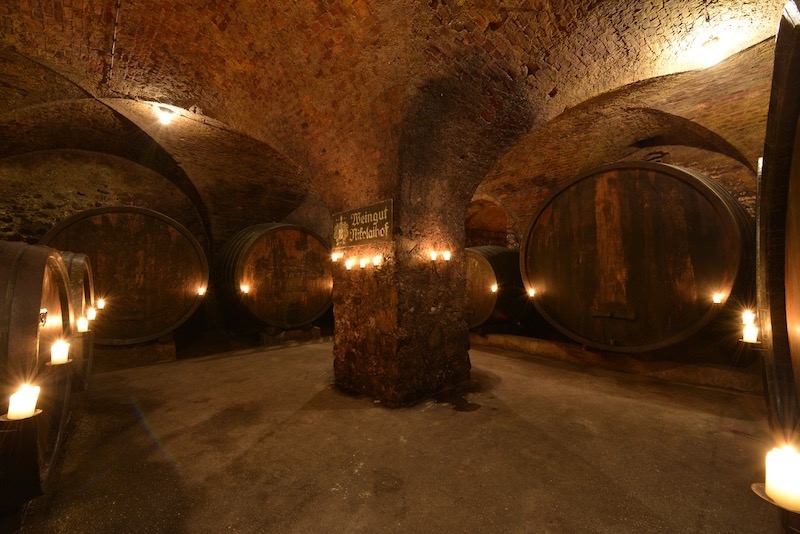
Nikolaihof is the oldest wine estate in Austria, for over two millennia, the grounds of Nikolaihof have been revered for both vinous pursuits and the mystical. Nikolaus Saahs, the current owner and winemaker at Nikolaihof, took over production from his parents in 2005. At the helm of this famed house, he keeps the long view in mind. Which course this makes sense when one considers the scale of history the estate encompasses. The Nikolaihof monastery was founded in 985 AD by the diocese of Passau. Its specific location was chosen to capitalize on pre-existing Celtic mystical reverence for the site dating back to the Roman era as well as the prestigious vineyards nearby. The wines of Nikolaihof are still barrel-aged in the ancient cellar built by the Romans in the 63BC. The current buildings stand on the original foundations and the barrel cellar itself is constructed in the Roman crypt. It’s incredible!
Winemaking on the site can be traced back to the Celts, with the first documented reference to wine from 470 AD.
Nikolaus’ mother, Christine, was a student of Rudolph Steiner’s School of Anthroposophy after being acquainted with his teaching in medical school. Christine became an important advocate for biodynamic agriculture in Austria and Europe. Nikolaihof was one of the first biodynamic wineries in Europe in 1971. The results speak for themselves: year to year Nicholas is able to harvest ripe, healthy grapes even in years where others may struggle. And yet the wines of Nikolaihof show remarkable balance. The category of “Smaragd” designates the ripest, high-alcohol wines of the valley with at least 12.5% ABV. Sometimes this leads to over-blown or flabby wines. Yet Nikolaihof’s Smaragd wines always fall closer to the 12.5% line representing elegant, balanced examples of the category.
“Organic, biodynamic winery whose wines express the earth, the whole earth and nothing but the earth. Nikolaihof’s wines are often incredibly thick, dense and uncompromisingly stony in character… JUST GIVE THESE WINES TIME. They’ll do everything for you that great wine can do, if you are patient. Early on you’ll easily see their sheer intensity, but specific details can be lost in a monolith of concentration, an opacity that can be perplexing if you don’t know what’s ahead. Thus detailed tasting notes are difficult if you feel the need to delineate skeins of flavors with sequences of associations. Here you just stand on the prow and feel the wind and look at the swollen waves of vinosity and hope you aren’t swept overboard. And hope you are. . . .”
Michael Skurnik
“A remarkable shelf life is a general feature of the wines of Nikolaihof, which tend to develop very slowly – what factors are responsible for the degree, we can only guess: an essential part of the reason is the decades of biodynamic management according to Nikolaus Saahs. However, you can also attribute it to the slow fermentation with natural yeasts and the customary maceration times, and also the fact that, while in principle the work is reductive, the maturation in large old oak barrels takes place in the perfect cellar environment. The shelf-life of the wines does not rely on the alcohol because even in the hot, ripe years the Smaragds do not significantly exceed 13 percent.”
Vinaria
In the Vineyard
Nikolaihof’s holdings are some of the farthest east in the Wachau near the village of Mautern on the Danube’s south bank. In fact one of Nikolaihof’s most ethereal wines is sourced from Steiner Hund, a vineyard just across the border in the Kremstal. These are also some of the oldest known vineyards in Europe with sites such as “im Weingebirge” being mentioned as far back as 470AD. Whether it’s Nikolaus biodynamic know-how, his focus on ancestral vinification techniques, or the quality of his terroir, the resulting wines are wildly unique and joyful.
Today the vineyard area totals 22 hectares, predominantly in the Wachau with a small area in neighbouring Kremstal. The soils are decomposed granite, gneiss and mica. Many of the sites across the domaine have old vines with the average age of over 50 years.
Nikolaihof has maintained a regime of biodynamic intervention and cultivation for over 40 years. Under Nikolaus this tradition continues. No pesticides or herbicides are used in their vineyards instead stinging nettles, manure, valerian tea and other traditional biodynamic preparations make up Nikolaihof’s inventory for pest management and overall vineyard health.
Top Sites
Im Weingebirge: The oldest named vineyard site in Europe, the soil is varied with loess on the higher terraces and deep topsoil over primary rock lower down the slope
Vom Stein: Vom Stein is a sub-site of the Silberbichel vineyard. The soils are gneiss with mica inclusions; there is a layer of loess and topsoil
Steiner Hund: Primary rock with river pebbles, very stony, just outside of the Wachau borders hence the labeling of “Reserve” and not Smaragd
Soil Types: Primary rock topped with humus or gravel, and eroded primary rock
Grape Varieties: 55% Riesling, 35% Grüner Veltliner, 10% Weissburgunder, Malvasier, Neuburger, and Chardonnay
In the Winery
Fermentations at Nikolaihof are long, slow, and spontaneous. Elevage happens in large, 40-year-old barrels or stainless steel with full lees contact until the wines are bottled. These bottlings could be many years from harvest. The Vinothek Riesling Severin Fass matures for 25 years in large oak barrels before bottling! Consider Nikolaihof’s lauded 1995 Vinothek Riesling: the first Austrian white wine to receive 100 points from Wine Advocate, it was bottled 17 years after harvest and released to the market in 2012. This wine sold out upon release but the 1997 Vinothek is available now and has received its share of acclaim (Advocate & Vinous Media both gave it 97 points.)
The result is some of the greatest white wines I have been privileged to taste. Delicate with strong mineral accents and deep concentration, their low alcohol and crystalline purity is the antithesis of the late picked, high extract styles that are famous from the Wachau. These are wines with incredible energy that will demand your time.
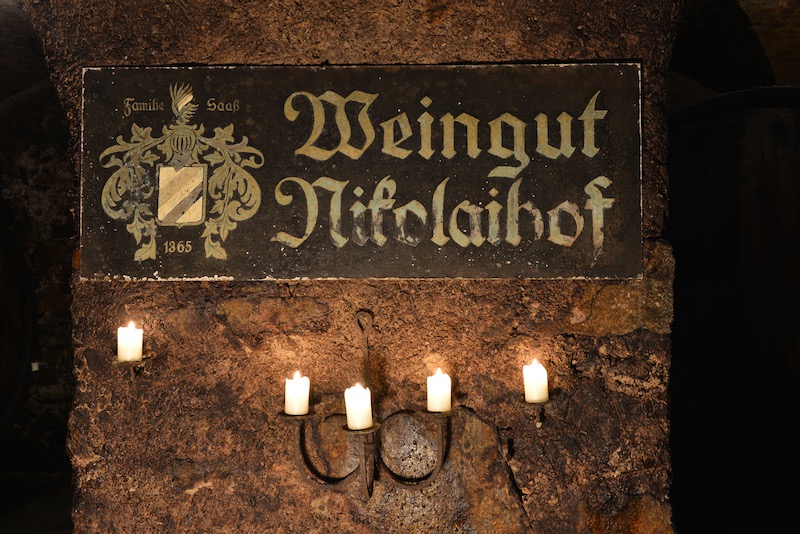
The Baumpresse ~ Basket Press
Used to make one wine each year. The pressing process takes 10 hours a significant time during which skin contact occurs releasing flavour and textural, phenolic compounds into the juice.
The Wachau Classification
The Steinfeder, Federspiel and Smaragd classifications are inseparably linked to the wines of the Wachau. The wines are always dry, made without any noticeable wood influence, while any form of sugar addition is not permitted. The categories are defined according to the level of maturity of the grapes.
Nikolaihof whilst using the classification makes many wines that although labeled within one classification sit above that classification in terms of real quality and pleasure in the glass. Nikolaihof achieves phenological, flavour and tannin, ripeness and sugar levels lower than many in the Wachau. The fruit is ripe, yet it is achieved at lower alcohol and with higher natural acidity than many other producers. This might sound like a technicality, the impact in the glass is significant. It’s only possible to pick ripe fruit at this alcohol when you have old, balanced vines that have seen attention to detail not just across a year but across decades. Such intensity is typically seen at much higher alcohol in Austria. Achieving flavour and phenolic ripeness at lower alcohol levels has the benefit of giving a wine freshness, energy, and a weightlessness, feather light feel not otherwise possible. I saw this time and time again making the wine at Yarra Yering. Our vintage would be finished before many were even halfway through picking!
STEINFEDER ®
The “Steinfeder” is an indigenous feather grass from the Wachau and the name for the lightest of the three Wachau wine categories. It was the first trademark introduced by Vinea Wachau in 1984. The maximum alcohol content is 11.5 % by volume. The style is lively and delicate, with refreshing fruit in the foreground.
FEDERSPIEL®
A “Federspiel” is a prey dummy used as a lure in falconry, a sport once popular in the Wachau. These wines have between 11.5% and 12.5% alcohol, which puts them at the golden mean of the Wachau’s stylistic spectrum. These wines are often labelled with their vineyard of origin. Federspiels combine vitality and character and their delicate aroma components make them ideal food matches.
SMARAGD ®
The Wachau vineyard terraces and their dry stone walls offer a natural habitat for numerous plants and animals; among them the local green “Smaragd” lizard that lends its name to the best known of the Vinea categories. The grapes for the Smaragd wines, which must have a minimum of 12.5% alcohol by volume, ripen in the best vineyard sites of the Wachau. They are harvested late and are true representatives of their terroir. The wines are concentrated and powerful, complex and very long-lived.
I can’t recall the connection between this lizard and the Smaragd classification. You’ll see it on some labels. The pic of this scaly friend was taken in Nikolaihof’s vineyards.
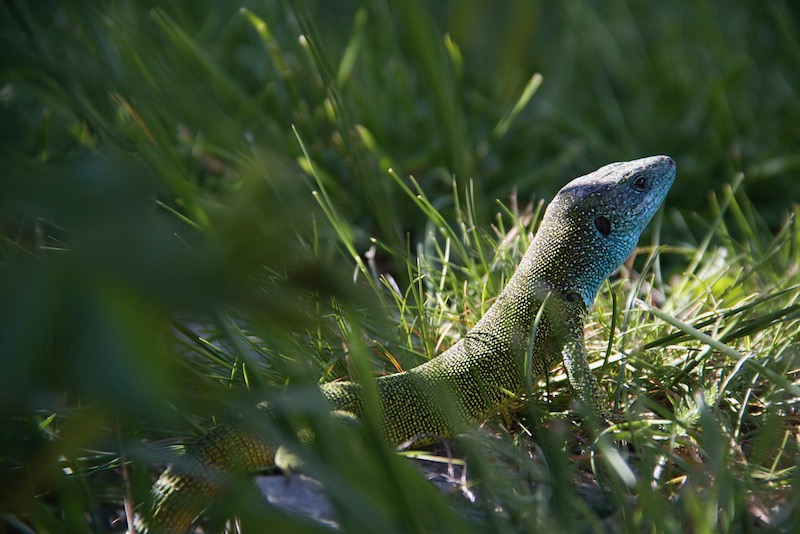
Where in the World is Nikolaihof?
Weingut Nikolaihof is based in the eastern extremes of the Wachau Valley with additional holdings just across the border in Kremstal.
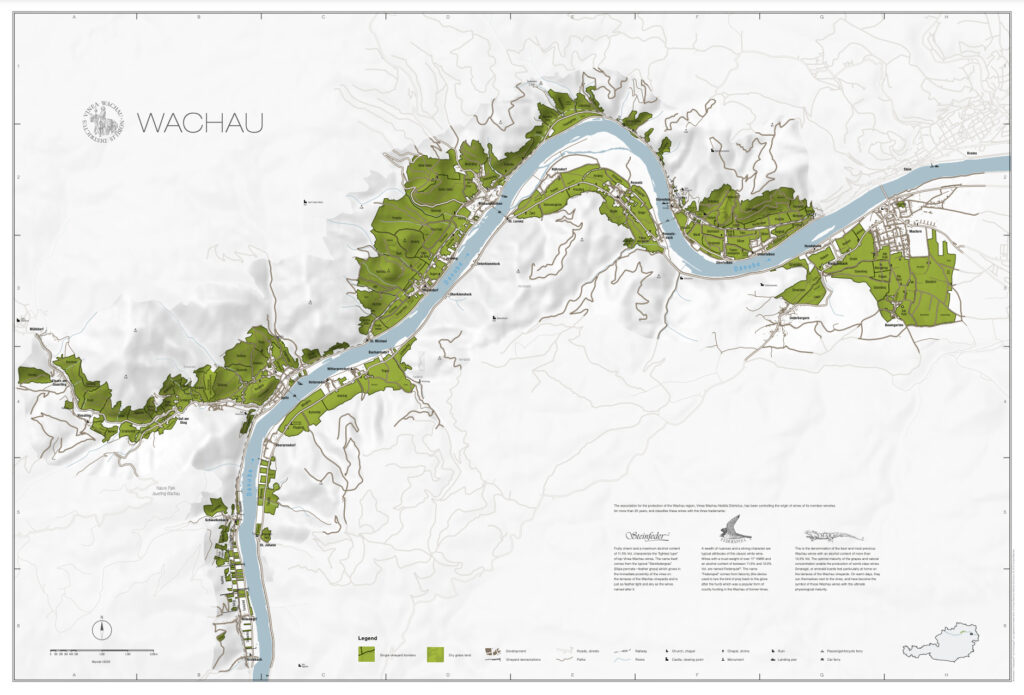
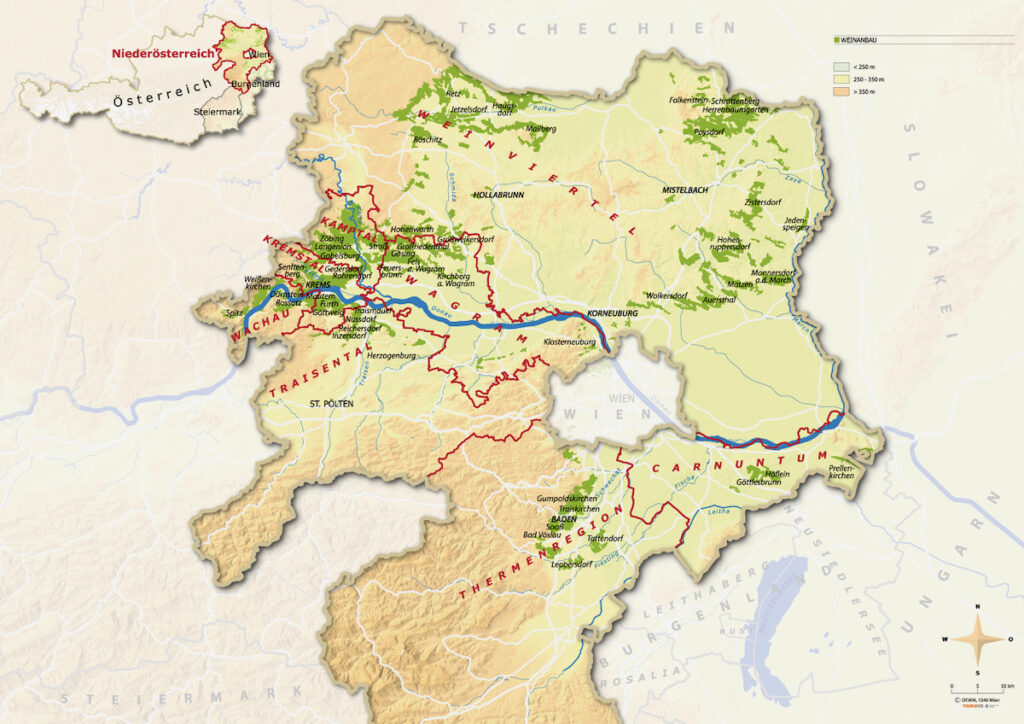
About the Wines
THE WHITE VARIETALS
2024 NIKOLAIHOF NEUBURGER

Neuburger is a traditional but little-known Austrian grape. You can also find it in the Czech Republic, Slovakia and in Romania
Variety: 100% Neuburger (Roter Veltliner x Silvaner)
Region: Wachau
Vineyard: From 14-year-old vines in the Im Weingebirge and the Silberbichl Bischofpoint.
Soil Type: Loess soil on Danube gravel
Fermentation & Élevage: Selective manual harvest. The wine is fermented on natural yeast without the addition of sugars, enzymes or flavor enhancers. Matured for 6 months in old oak barrels
Taste: This Neuburger has a full and soft taste and has a seductive scent of blooming flower meadows in summer
***Previous Vintage*** The 2023 Neuberger Aus den Gärten comes exclusively from Mautern. A small portion was kin-fermented to add structure. The nose offers lovely reduction and plunges straight into vivid juiciness, with a sprightliness that is surprising for Neuburger, which is usually far more rounded. This is a vivid, bright, light-foorted wine with a gorgeous phenolic framework to finish.
2022 NIKOLAIHOF CHARDONNAY
Variety: 100% Chardonnay
Region: Wachau
Vineyard: Own vineyards.
Soil Type: Loess soil on Danube gravel
2023 NIKOLAIHOF GELBER MUSKATELLER
My note on the 2021 Muskateller 11.5% Screwcap
Carrying a little CO2 making for a lively palate when combined with plentiful fine acid. Muscat shining on the nose with all of those floral and fragrant terpenes. They can be overbearing in some wines, not so here, they sit in balance and harmony with citrus ad spice. A salty mineral pleasantly sour hit, on again, a beautifully weighted palate. As the CO2 blows off the expression builds. A Playful, fun and delicious dry Muskateller.
Variety: 100% Gelber Muskateller AKA Muscat à Petits Grains Blanc
Region: Wachau
Vineyard: Own vineyards.
Soil Type: Loess soil on Danube gravel
Fermentation & Élevage: The grapes undergo spontaneous fermentation in large tanks (2000 to 12000 liters) where they remain for approximately 6 months to ripen. Spontaneous fermentation on large tanks (2000 to 12000 litres) where they mature for approximately 6 months
Taste: Delicate, fruity and juicy summer wine. Aromatic and floral with beautiful acidity in the long finish.
CURRENT RELEASE
THE RIESLINGS
2017 NIKOLAIHOF GUTSWEIN RIESLING

This became the Nikolaihof “manor” wine after a natural fermentation stop. Bright and intense on the nose, with aromas of minerality, wet forest floor, sweet peach, white flowers, and a hint of dry bread and honey. It fits perfectly with Asian and spicy dishes due to its light sweetness.
Variety: 100% Riesling
Region: Wachau
Vineyard: Own vineyards.
Soil Type: Loess soil on Danube gravel
Fermentation & Élevage: Harvested manually. This is part of the ‘Vom Stein’ Riesling Federspiel, which was used as ‘gutswein’ after the natural cessation of fermentation. 6 months maturation and bottled in April 2018. Spontaneous fermentation on large foulers (2000 to 12000 liters)
Taste: Clear and intense on the nose, with aromas of minerality, forest floor, sweet peach, white flowers and a hint of dry bread and honey with a slightly sweet aftertaste.
Alcohol: 13.5%
Acidity: 6.2 grams per liter
Residual sugar: 12.1 grams per liter
"The 2017 Riesling Gutswein was harvested late with some botrytis and stopped at 12g/L of residual sweetness. Juicy apricot and peach beckon on the nose, promising fruity generosity that the palate promptly delivers - smooth and off-dry. Herbal lift adds dimension, while concentration and ripeness fill the mouth. Fine concentration, acidity and a pithy sense of phenolics and citrus are beautifully set against that slight sweetness, making this an alluring proposition. Off dry."
2023 NIKOLAIHOF RIESLING FEDERSPIEL
Nikolaihof’s Fiederspiel level the middle ripeness of the classifications.
Vom Stein: This site is a sub-site of the larger Silberbichel vineyard. Located south east of the village, this is just 5.25 Ha and is a slight incline, sloping east, on the easternmost border of the Silberbichel vineyard. The soils are gneiss with mica inclusions; there is a layer of loess and topsoil here – 60-120cm before you start to hit primary rock. Nikolaihof is the only winery to bottle this site on it’s own, but it is not a true monopole.
Variety: Riesling
Region: Wachau
Vineyard: Vom Stein
Soil Type: Gneiss, mica inclusions, and loess
Fermentation & Élevage: Large, old casks
"The 2023 Riesling Aus den Garten Federspiel, picked exclusively in Mautern, crackles as much with citrus as with flinty reduction. The palate is light-footed yet fluid, carrying ripe tangerine and mandarin flavours. Juicy, enticing, mouthwatering and aromatic. Bone-dry, clean-cut and irresistible, it is simply chock-full of sprightly energy."
2019 NIKOLAIHOF RIED VOM STEIN RIESLING SMARAGD

Nikolaihof’s Smaragd level the ripest of the classifications.
Vom Stein: This site is a sub-site of the larger Silberbichel vineyard. Located south east of the village, this is just 5.25 Ha and is a slight incline, sloping east, on the easternmost border of the Silberbichel vineyard. The soils are gneiss with mica inclusions; there is a layer of loess and topsoil here – 60-120cm before you start to hit primary rock. Nikolaihof is the only winery to bottle this site on it’s own, but it is not a true monopole.
Variety: Riesling
Region: Wachau
Vineyard: Vom Stein
Soil Type: Gneiss, mica inclusions, and loess
Fermentation & Élevage: 4 1/2 years in large, old casks
Alcohol: 13%
Acidity: 6.4 grams per liter
Residual sugar: 3.8 grams per liter
"The 2019 Riesling vom Stein Smaragd smells of fresh Mirabelle, ripe Amalfi lemon and a touch of chervil on a yeasty, smooth nose. The palate presents all this in one smooth, cooling flow, with notions of lemon becoming ever more prominent and apricot making a charming, perfumed appearance. Riesling's exuberance has been tamed into soothing mildness here. Full marks for charm and exquisite purity of fruit. Bone dry."
Aged for four-and-one-half years in large wooden casks, the 2019 Ried Vom Stein Riesling Smaragd opens with a clear, pure and intense as well as savory/mineral nose that represents the Danube gravel of this terroir that is intermingled with loess and loam. On the palate, this is a rich and round, dense and savory/saline-finishing Riesling that is not bone dry and stopped the natural fermentation with 3.8 grams per liter of residual sugar. 13% stated alcohol. Natural cork. Tasted in January 2025.
2017 NIKOLAIHOF RIED STEINER HUND RIESLING

Under a thin layer of humus, the vine roots dig deep in the hard, primary rock and bring forth extremely balanced wines with pronounced mineral character and refined elegance.
Grape: Riesling
Region: Kremstal
Vineyard: Steiner Hund with a soil of Gneiss and a thin layer of humus
Fermentation & Élevage: Harvested manually. The grapes undergo spontaneous fermentation in large tanks (2000 to 12000 liters) where they remain for approximately 2.5 years to mature.
Taste: Seductive aroma of apricot, peach, rose and light spiciness. Elegant lively fruity, off-dry taste with ripe acidity, broad flavor structure. The aftertaste continues for a long time.
Alcohol: 12.5%
Acidity: 6.6 grams per liter
Residual sugar: 4.0 grams per liter
"The 2017 Riesling Steiner Hund, formerly called Reserve, was grown in Stein on terraced, stony vineyards across the Danube, and is thus labeled Neiderosterreich. Subtle peach and straw on the nose have the slightest floral overtone. Concentrated, buffered and intense, the palate is vivid, with lemony, waxy, yeasty brightness. Those flavours arrive and persist with depth that is long, lasting, enticing and appetising in its super-salty style. Bone dry."
The 2017 Ried Steiner Hund Riesling is pure, precise, coolish and flinty as well as herbal on the nose. Tight, fresh, intense and mineral on the palate, this is a pure, bright, fresh and energetic, savory and very persistent Riesling with stimulating character and a long, complex finish without too much power. In fact, it is a rather light yet dense and intense Hund. This is what Riesling can do: inspire, salivate and entertain. 12.5% stated alcohol. Natural cork. Tasted in January 2025.
2015 Nikolaihof Baumpresse Riesling
The gentle giant presses the grapes for over ten hours, which then mature into wines of exceptional character. Please decant.
Grape: 100% Riesling
Region: Wachau
Vineyard: Loam, loess, paragneiss rock
Fermentation & Élevage: 5½ years in a 2,000L casks.
Alcohol: 12.5%
Acidity: 6 grams per liter
Residual sugar: 5.6 grams per liter
A baumepress is a traditional Austrian basket press.
"The 2015 Riesling Baumpresse was pressed in the historic press operated by a single oak beam. It was bottled in 2020 and released in spring 2023. Waxiness hits the nost first, followed by dried lemon peel and zest. The palate is super-smooth, with evolution that presents an intense waxiness, almost an oiliness, propelled by lemony intensity. Glints of ripe apricot shimmer, but the palate returns to its golden mean of dried lemon peel. The contrast between rich flavour and slender palate is mind-boggling. This is earthy yet elegant, memorable and intense in its flavour, yet quiet in its delivery. The Baumpresse is gorgeous and long, closing with hints of waxy citrus. Bone dry."
2008 NIKOLAIHOF VINOTHEK RIESLING (bottled 04/24)
"The 2008 Riesling Vinothek was bottled in April 2024 and is current release. A soft sense of lanolin and creaminess defines the nose, edged by the gentlest citrus zestiness. The palate is superbly bright and very slender, carrying more of that lanolin character with the smoothest, slightest texture. Brightness, earthiness and luminosity are strangely combined in this elixir-like wine. Super slender, concentrated and quiet, it really goes under your skin."
From the site Im Weingebirge, fermented in stainless steel, aged in a large oak cask and bottled in April last year, the 2008 Riesling Vinothek is clear and deep on the initially somewhat untamed and gamey as well as flor-inflected and slightly oaky nose that nevertheless indicates very clear and healthy, elegant and concentrated fruit with flinty notes, and it gains clarity and complexity with air. Aeration is highly recommended here and gives way to ginger notes and detailed terroir notes representing the amphibolite, loess and paragneiss of the soil. On the palate, this is a concentrated, fresh and elegant, tightly structured and refreshing mineral Riesling whose grip is still firm and biting (12 milligrams per liter of free sulfur dioxide). This is still a discreet wine that is to be handled with care and a carafe. I kept the bottle for five days to taste the wine again since the first impression represented caged potential rather than revelation. The second tasting showed a little bit more open and finessed, pure, fresh and saline yet still not singing. 12.5% stated alcohol. Natural cork. Tasted in January 2025.
1997 NIKOLAIHOF VINOTHEK SEVERIN FASS RIESLING MAGNUM
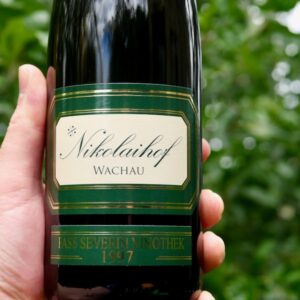
Given the reputation of the predecessor to this wine, the 1995 and the Nikolaihof wines I’ve tasted to date, I have no doubt this wine is exceptional! Magnums are coming via a pre-arrival offer.
The name ‘Fass Severin’ refers to the Barrel ‘Fass’ and its name Severin in which the wine was aged.
Aged for 25 years in 3,5000 liter old casks.
The 1997 Riesling Vinothek Severin Fass was aged for 25 years in a large, traditional oak cask (filtered, though not on the lees) and opens with an intense yet pure, fresh and spicy, finely oaky bouquet with a deep, mineral tone of crushed stones. On the palate, this is a very intense and complex Riesling slowly building up and revealing great finesse and balanced juiciness. The wine develops a sustainable, aromatic and structured finish with great finesse, lingering salinity and fine tannin grip. A fabulous, intense and elegant Riesling that is incredibly young in terms of freshness but ageless and immortal by its structure and fruit intensity. Natural cork. Tasted in June 2022. Drink 2022-2050
Welcome to the wine time machine! Although there are deep, mature aromas that range from an old library to quince paste and beeswax, after a little aeration some remarkably fresh citrus character emerges. Great concentration and restrained power on the wonderfully harmonious palate. Very long, bone-dry finish. Bottled in early 2022 after 25 years maturing in a large barrel of neutral oak. The barrel name, Fass Severin, is on the label. From biodynamically grown grapes with Demeter certification.
THE GRÜNERS
2020 NIKOLAIHOF GRÜNER VELTLINER FEDERSPIEL LATE RELEASE
Variety: Grüner Veltliner
Region: Wachau
Vineyard: Old vineyard with a clay, loess and paragneiss-rich soil
Fermentation & Élevage: Harvested manually. The grapes undergo spontaneous fermentation.
Taste: An elegant Grüner Veltliner. Delicate pepper, almond and ripe fruit in the scent. The taste has slightly tingling acidity, slightly spicy and fresh ripe fruit
Alcohol: 12.5%
Acidity: 5.9 grams per liter
Residual sugar: 1.0 grams per liter
Previously called Im Weingebirge, the 2020 Grüner Veltliner Federspiel comes along without single-vineyard designation and opens intense and aromatic on the nose that is deep, precise and focused and reveals perfectly ripe and intense fruit. Round and lush on the palate, this is a mouth-filling, salty-piquant and mineral structured Federspiel with substance, grip and a sustainable finish. 12% alcohol. Tasted at the domaine in June 2021. Drink 2021-2045
2019 NIKOLAIHOF RIED IM WEINGEBIRGE GRÜNER VELTLINER SMARAGD

This wine is from the ripest Smaragd classification.
Thought to be the oldest documented vineyard, the name “Im Weingebirge”, Wine Mountains, dates back to the 5th Century. The wines from this vineyard are known to have impressive depth and minerality. The soil is varied with loess on the higher terraces and deep topsoil over primary rock lower down the slope. The wine ages on its lees in old barrels, giving it a creamy texture.
Variety: Grüner Veltliner
Region: Wachau
Vineyard: Im Weingebirge
Soil Type: Clay, loess, and paragneiss
Fermentation & Élevage: 3½ year in large, old casks
Alcohol: 13%
Acidity: 5.2 grams per liter
Residual sugar: 2.2 grams per liter
"The 2019 Gruner Veltliner Im Weingebirge Smaragd grew in loess above gneiss and was fermented and aged in wood, where is stayed for three years before bottling and release in Spring 2024. Wax, yeast and a touch of honey suggest evolution on the nose. The waxiness, perfumed with orange peel, follows through onto the surprisingly light but concentrated body. Balm-like texture accentuates the waxiness and completely buffers the undeniable, vivid acidity. This is an unusual but beautifully textured wine with a noble, pleasant bitterness on the long finish. Bone dry."
The 2019 Ried Im Weingebirge Grüner Veltliner Smaragd is deep, intense and aromatic on the nose that reveals flinty notes of crushed rocks (paragneiss) and ripe, yellow stone fruits. Round, smooth and refined on the palate, this is a full-bodied, elegant and savory, long and seriously structured wine from the six-hectare cru that is located within the Ried Alte Point in Mautern. The finish is savory and saline yet also quite powerful. I would recommend cellaring the wine for at least another five or seven years to integrate the tannins that still stand out in the finish. 13.5% stated alcohol. Natural cork. Tasted in January 2025.
2012 NIKOLAIHOF GRÜNER VELTLINER STEINTERRASSEN
Variety: Grüner Veltliner
Region: Wachau
Vineyard: Terraced, old vineyard with a clay, loess and paragneiss-rich soil
Fermentation & Élevage: Manual harvest in 2012. Careful pressing followed by fermentation on the lees. Subsequently aged for 11 years in large wooden barrels and bottling in September 2023. 11 years maturation in large old casks (2000 to 12000 liters)
Taste: Light golden yellow with green reflections, fruity but also mainly spiciness and spices. The wine is very aromatic, deep, slightly spicy and has some nice earthy notes. Silky soft, nice acidity and a long finish with some waxy notes that the long ripening phase brings.
Alcohol: 12.0%
Acidity: 6.2 grams per liter
Residual sugar: <2.0 grams per liter
"The 2012 Gruner Veltliner Steinterrassen was bottled in May 2023 after almost 12 years in a 6,500L barrel. Lovely smokiness gives this 11 year old wine a most youthful swing on the nose. The palate, likewise, is vivid with a freshness and youthful verve. If I did not know better, I would think this is a much more recent wine. The palate is vibrant and sprightly, alive with white pepper that pervades lemony Mirabelle flesh - slender and bright. This is a lovely, youthful marvel. What enduring freshness. What lovely acidity. What a wine. With lightness, freshness, acidity, vivacity and spice, it is a force of life, with a sheer, endless echo of lemon. Bone dry." Bottled 5/23
MUSEUM RELEASE
THE RIESLING
NIKOLAIHOF RIED VOM STEIN RIESLING FEDERSPIEL
2005 NIKOLAIHOF RIED VOM STEIN RIESLING FEDERSPIEL
The late-released 2005 Riesling Smaragd Vom Stein in fact represents only half of what was produced under that name. The Saahs family would have preferred to have left the total volume in cask for future release, but that wasn’t practical in this instance, so they split it. Raspberry, brown spices, incense, and sweet floral notes result in an unusual and scintillating bouquet. On the palate, there is a dramatically dynamic exchange of berry, citrus, and floral flavors, but also an adamant underlying stoniness. The finish is long and intriguing, the more so the longer this sits in the glass (which, by the way, is the main basis on which the decision is made which few wines will enjoy extended barrel aging). This could easily reel you in and keep you riveted to the table for an entire evening. If you’re savvy, you’ll lay some away to compare with the “same” wine matured in cask. Of course, the family is not giving odds as to when they (or rather, they would insist, the wine) will decide to bottle part two: a Nikolaihof “Vinothek” bottling can sometimes rest in Fuder for more than a decade.
NIKOLAIHOF RIED VOM STEIN RIESLING SMARAGD
2008 NIKOLAIHOF RIED VOM STEIN RIESLING SMARAGD
The current release in its category is Nikolaihof's 2008 Riesling Smaragd Vom Stein, which displays near delicacy as well as transparency to a fine sense of mineral, endearing traits that one notes today in a great many of the best Wachau wines of this challenging and initially underappreciated vintage (on more of which I shall shortly, belatedly, publish notes). Buddleia, peony and elder flower headily grace the nose; a juicy, buoyant, polished palate generously fills with white peach and grapefruit, suffused with floral and herbal essences and transparent to a shimmering array of mineral nuances; and a dynamic, uplifting, and refreshing finish clinches this wine's irresistibility. It should retain its beauty for at least the better part of a decade, and quite possibly longer.
2012 NIKOLAIHOF RIED VOM STEIN RIESLING SMARAGD
Raised in a traditional oak cask for 2.5 years, the 2012 Riesling Smaragd Vom Stein opens with a deep, ripe and very intense pip fruit aroma on the nose. On the palate, this is a rich, ripe and concentrated Riesling with a lot of power and complexity, but also freshness and mineral vitality. The finish is firm, complex and very long, announcing a great aging potential. So much salt and tension here!
2016 NIKOLAIHOF RIED VOM STEIN RIESLING SMARAGD
Bottled in April this year (2021), the 2016 Vom Stein Riesling Smaragd is perfectly ripe and concentrated on the precise, coolish and flinty nose that reveals apricot and white peach aromas. Full-bodied, round and crystalline, this is a fresh, very elegant and textural Vom Stein in a linear and classic style. The finish is intense and reveals firm tannins and makes this an excellent gastronomic wine. 12.5% alcohol. Tasted at the domaine in June 2021. Drink 2021-2040
2017 NIKOLAIHOF RIED VOM STEIN RIESLING SMARAGD
The Mautern 2017 Riesling Ried Vom Stein Smaragd offers a pure, refined and finely oxidative bouquet of bright, ripe fruits intermingled with smoky and saline terroir notes as well as some delicate oak. Round and intense on the palate, with fine, playful and persistently saline acidity, this is a full-bodied, dense and very elegant Riesling with striking intensity and finesse. 12.5% stated alcohol. Natural cork. Tasted in October 2022. Drink 2022-2047
NIKOLAIHOS WACHAU RIESLING KLAUSE
2007 Nikolaihof Wachau Klausberg Riesling Privatreserve
2014 NIKOLAIHOS WACHAU RIESLING KLAUSE
Previously called Klause am Berg Privat, the Kremstal 2014 Riesling Klause is beautifully intense, clear and aromatic on the concentrated and immediately seductive nose. Crystalline, refined and highly elegant on the palate, this is a medium to full-bodied, lush and salty Riesling with crystalline acidity and very fine tannins. Stewed fruit aromas populate the finish and result in perfect roundness. 12.5% alcohol. Tasted at the domaine in June 2021. Drink 2021-2045
NIKOLAIHOS RIESLING REID 'STEINER HUND'
2014 NIKOLAIHOS RIESLING REID 'STEINER HUND'
From hard primary rock soils with just a very thin layer of humus, the shining citrus-yellow colored 2014 Steiner Hund Riesling is clear, deep, pure and flinty on the discreet but subtly intense, complex and refined nose with its hidden floral, herbal and refreshing stony aromas. Full-bodied, pure and highly elegant on the palate, this Kremstal Riesling is lush and full of energy and vitality. Its finish is vibrantly fresh and persistently salty. This is a highly promising, Smaragd-styled Riesling in a purely mineral style. No hints of botrytis. Bottled in September 2017. Tasted at the Nikolaihof in Mautern/Wachau, September 2018. Drink 2025-2050
2016 NIKOLAIHOS RIESLING REID 'STEINER HUND'
From Krems-Stein in the Kremstal DAC and thus not marketed as Smaragd (and not even under the Kremstal appellation, which seems to be the unwritten paragraph in the "Codex Wachau" of the Vinea Wachau group), the 2016 Ried Steiner Hund Riesling offers a clear, intense and savory nose of ripe (and overripe) fruits intermingled with crystalline salinity. On the palate, this is a tight, tart, firm and structured yet also intense and densely textured, very elegant and persistent Riesling with structuring tannins and a clear and defined finish with floral notes. This is impressive in its complexity, vitality and mineral drive. A gorgeous wine! 12.5% stated alcohol. Natural cork. Archive Release 2024. Tasted in January 2025. Drink 2025-2060
NIKOLAIHOF WACHAU RIESLING STEINRIESLER
2007 Nikolaihof Wachau Riesling Steinriesler (bottled June 2019)
Bottled in June 2019 after 12 years in a large oak vat, the 2007 Riesling Steinriesler is from the Vom Stein in Mautern and exhibits an intense and matured bouquet with caramel and leathery/feral as well as concentrated fruit but also crystalline, stony aromas. Deep, coolish and elegant. On the palate, this is a crystalline, refined and pure, very complex and concentrated wine with a great and complex finish that is structured, still tannic and seriously biting but with the right concentration and power for a long-distance run. It is mouth-watering, enormously tensioned and pushing on the finish. A great dry Riesling for real Riesling lovers. The wine should be decanted for maybe a day or two. 12% alcohol. Tasted at the domaine in June 2021. Drink 2021-2060
THE GRÜNERS
NIKOLAIHOF GRÜNER VELTLINER 'HEFEABZURG'
2020 NIKOLAIHOF GRÜNER VELTLINER 'HEFEABZURG'
The 2020 Grüner Veltliner Hefeabzug is very clear and bright in color and flavors, with refreshing lime and lemon zest aromas, great precision, definition and finesse. Quite substantial on the palate, this is a textural, intense, refreshing and remarkably persistent Veltliner with serious grip and a stimulating citric bitter note on the finish. Tasted at the domaine in June 2021. Drink 2021-2040
NIKOLAIHOF Grüner Veltliner Federspiel Ried 'Im Weingebirge'
2007 NIKOLAIHOF Grüner Veltliner Federspiel Ried 'Im Weingebirge'
The 2007 Gruner Veltliner Federspiel Im Weingebirge is another remarkably buoyant and poised Nikolaihof triumph. Lentil, rhubarb, lemon, white peach, plum distillate, and tobacco are among the elements that come wreathed in flowers and smoke, and underlain by savory, saline, scallop-like suggestions. That striking mineral melange, combined with sheer extract, give this wine a mysterious sense of sweetness, even though it is analytically as dry as it is delicate. If you think lightness isn't compatible with profundity of flavor, this -little- wine will set you straight!
NIKOLAIHOF Grüner Veltliner Smaragd Ried 'Im Weingebirge'
2015 NIKOLAIHOF Grüner Veltliner Smaragd Ried 'Im Weingebirge'
Bottled at the end of April this year (2018), the 2015 Im Weingebirge Grüner Veltliner Smaragd is clear, deep and intense on the nose with its subtle aromas of crushed stones and lemons. Some animal leather and wild boar scents here as well. Full-bodied and intense but also very elegant and finessed on the palate, this is a lush and impressively long and very tensioned, highly expressive Smaragd made for decades. Its slightly oxidative style reminds me of traditional white Riojas, but the crystalline acidity and mineral character is clearly Wachau. A potential top-scorer, but the wine is far too young to be served today. 12.5% alcohol. Drink 2030-2060
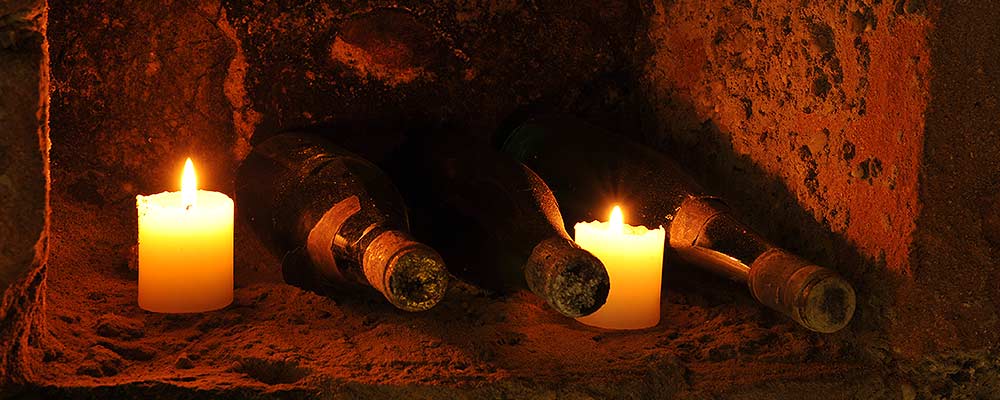







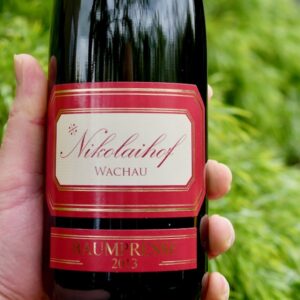
You must be logged in to post a comment.